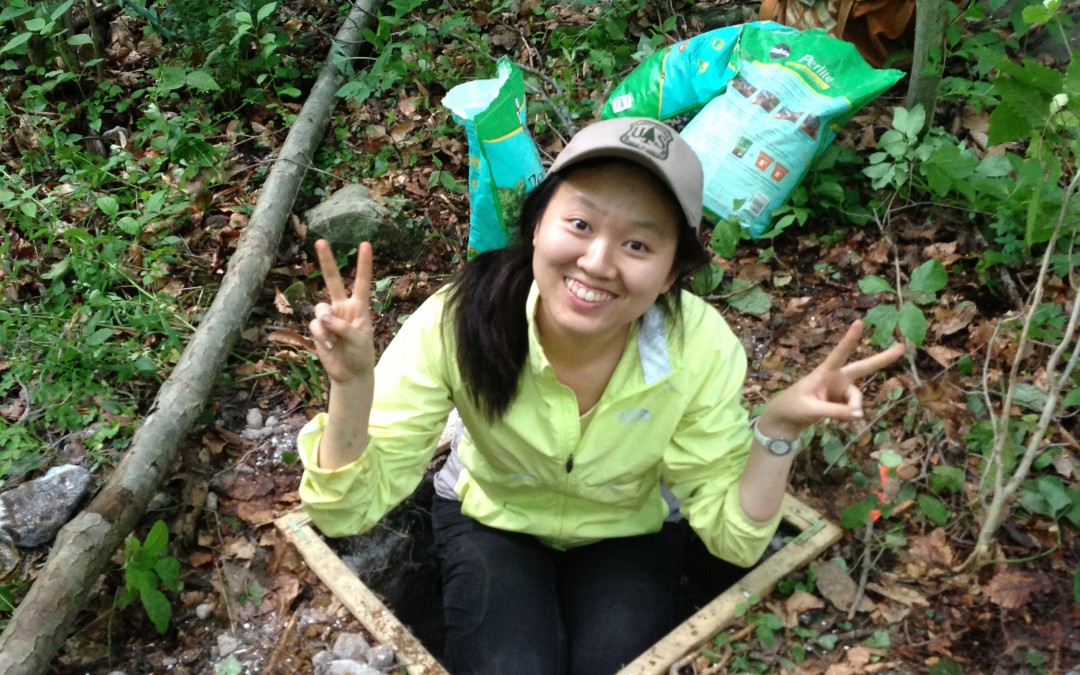
by xubing | Jul 1, 2016 | In other news
 I grew up in Beijing and got my Bachelor’s and Master’s degrees from Peking University. My research interests are the interactions between forest carbon cycle and global environmental changes at multiple spatial and temporal scales. I arrived at University of Pennsylvania at 2011, and started to work with Dr. Fred Scatena. After he passed away suddenly in 2013, I transferred to Dr. Alain Plante’s lab. During my time in Plante’s lab, I completed my PhD project about the forest biomass and soil carbon stocks changes in the Delaware River Basin. This project was started from 2001, when 77 plots in three research area were established. I led a field crew with investigators from US Forest Service and Penn students, revisiting 61 of the plots, measuring forest biomass and collecting soil samples using two sampling methods. Forest biomass data from two field surveys were used to address the linkage between forest biomass C stock change and tree demographic change over the past decade. Two soil sampling methods were compared to reduce the uncertainties of soil CN content estimations. Based on the results of field measurements, a process-based ecosystem model (PnET-CN) was parameterized and used to simulate the spatial distribution of forest C pool and fluxes, and to qualify the impacts of environmental changes on forest C cycle. This project was supported by US Forest Service, and co-advised by Dr. Yude Pan. In the past five years, I had a very good time studying above and below- ground forest carbon cycles in the field, the lab and in the digital world. In the next few years, I will work as a postdoctoral fellow with Dr. Altaf Arain at McMaster University in Hamilton, Ontario, Canada, and go on exploring forest carbon dynamics using micrometeorology and remote sensing technique.
I grew up in Beijing and got my Bachelor’s and Master’s degrees from Peking University. My research interests are the interactions between forest carbon cycle and global environmental changes at multiple spatial and temporal scales. I arrived at University of Pennsylvania at 2011, and started to work with Dr. Fred Scatena. After he passed away suddenly in 2013, I transferred to Dr. Alain Plante’s lab. During my time in Plante’s lab, I completed my PhD project about the forest biomass and soil carbon stocks changes in the Delaware River Basin. This project was started from 2001, when 77 plots in three research area were established. I led a field crew with investigators from US Forest Service and Penn students, revisiting 61 of the plots, measuring forest biomass and collecting soil samples using two sampling methods. Forest biomass data from two field surveys were used to address the linkage between forest biomass C stock change and tree demographic change over the past decade. Two soil sampling methods were compared to reduce the uncertainties of soil CN content estimations. Based on the results of field measurements, a process-based ecosystem model (PnET-CN) was parameterized and used to simulate the spatial distribution of forest C pool and fluxes, and to qualify the impacts of environmental changes on forest C cycle. This project was supported by US Forest Service, and co-advised by Dr. Yude Pan. In the past five years, I had a very good time studying above and below- ground forest carbon cycles in the field, the lab and in the digital world. In the next few years, I will work as a postdoctoral fellow with Dr. Altaf Arain at McMaster University in Hamilton, Ontario, Canada, and go on exploring forest carbon dynamics using micrometeorology and remote sensing technique.

by Alain | May 27, 2016 | In other news
2016 is turning out to consist of a number of elegant sets of threes, and thus I’m officially declaring 2016 the Year of the Triangle – at least for myself. In the next three (get it?) blog posts, I will explore three different sets of threes under which my year in research can be organized. In part 1 (below), I will report on my sabbatical visit to New Zealand and how it evolved into a three-way collaboration between labs in New Zealand, the US and Canada. In part 2 (coming soon), I’ll describe one conceptual framework that the Powell Center working group on soil carbon came up with to guide our thinking about the next generation models for soil carbon cycling. And in part 3 (coming soon), I’ll describe the triangulation of data, code and results, and how we are using these in ongoing projects.
Part 1: How a trip to New Zealand brought me back to Canada
With the support of the America-New Zealand Soil Science Professional Exchange Award from the Soil Science Society of America, I spent six weeks of my recent sabbatical in Christchurch, New Zealand working with colleagues at Plant & Food Research (PFR) in Lincoln. During my stay, Drs. Mike Beare, Denis Curtin and I discussed a number of ongoing PFR projects, and how I might contribute to them. One of my current research goals is to explore the connections between the biogeochemical stability of soil organic matter and its thermal stability as measure by thermal analysis during ramped combustion. This is an evolving field of study and there are few research groups applying this approach, so there is still much to be learned on whether thermal stability can indeed be used as a proxy for assessing soil organic matter’s resistance to decomposition.
In a recent study (published here), Denis and others examined the biodegradability of soil organic matter by comparing laboratory incubation assays to a different thermal analysis technique called RockEval. RockEval was originally developed to characterize oil-bearing sedimentary rocks, but has recently been applied to the study of soil organic matter. It uses a combination of ramped pyrolysis (burning in the absence of oxygen) and combustion (burning in the presence of oxygen), while the techniques that I typically used consist only of combustion. The lead author on the study was someone that I’ve known for a long time, Dr. Ed Gregorich from Agriculture & Agri-Food Canada (AAFC). Ed has made a number of research visits to New Zealand to work with Denis and Mike.
So between the three nodes at PFR in New Zealand, AAFC in Canada and myself at Penn in the U.S., we are exploring the possibility of a three-way collaboration that would explore a wide range of possible ways to express thermal analysis data on soil organic matter from both ramped combustion and RockEval, with laboratory incubation data. I’ve done this kind of correlation before (published here and here), but the comparison with RockEval and the larger and more diverse set of soils from New Zealand and Canada provide a novel and potentially more robust test of the possible link between thermal and biogeochemical stability of soil organic matter.

 I grew up in Beijing and got my Bachelor’s and Master’s degrees from Peking University. My research interests are the interactions between forest carbon cycle and global environmental changes at multiple spatial and temporal scales. I arrived at University of Pennsylvania at 2011, and started to work with Dr. Fred Scatena. After he passed away suddenly in 2013, I transferred to Dr. Alain Plante’s lab. During my time in Plante’s lab, I completed my PhD project about the forest biomass and soil carbon stocks changes in the Delaware River Basin. This project was started from 2001, when 77 plots in three research area were established. I led a field crew with investigators from US Forest Service and Penn students, revisiting 61 of the plots, measuring forest biomass and collecting soil samples using two sampling methods. Forest biomass data from two field surveys were used to address the linkage between forest biomass C stock change and tree demographic change over the past decade. Two soil sampling methods were compared to reduce the uncertainties of soil CN content estimations. Based on the results of field measurements, a process-based ecosystem model (PnET-CN) was parameterized and used to simulate the spatial distribution of forest C pool and fluxes, and to qualify the impacts of environmental changes on forest C cycle. This project was supported by US Forest Service, and co-advised by Dr. Yude Pan. In the past five years, I had a very good time studying above and below- ground forest carbon cycles in the field, the lab and in the digital world. In the next few years, I will work as a postdoctoral fellow with Dr. Altaf Arain at McMaster University in Hamilton, Ontario, Canada, and go on exploring forest carbon dynamics using micrometeorology and remote sensing technique.
I grew up in Beijing and got my Bachelor’s and Master’s degrees from Peking University. My research interests are the interactions between forest carbon cycle and global environmental changes at multiple spatial and temporal scales. I arrived at University of Pennsylvania at 2011, and started to work with Dr. Fred Scatena. After he passed away suddenly in 2013, I transferred to Dr. Alain Plante’s lab. During my time in Plante’s lab, I completed my PhD project about the forest biomass and soil carbon stocks changes in the Delaware River Basin. This project was started from 2001, when 77 plots in three research area were established. I led a field crew with investigators from US Forest Service and Penn students, revisiting 61 of the plots, measuring forest biomass and collecting soil samples using two sampling methods. Forest biomass data from two field surveys were used to address the linkage between forest biomass C stock change and tree demographic change over the past decade. Two soil sampling methods were compared to reduce the uncertainties of soil CN content estimations. Based on the results of field measurements, a process-based ecosystem model (PnET-CN) was parameterized and used to simulate the spatial distribution of forest C pool and fluxes, and to qualify the impacts of environmental changes on forest C cycle. This project was supported by US Forest Service, and co-advised by Dr. Yude Pan. In the past five years, I had a very good time studying above and below- ground forest carbon cycles in the field, the lab and in the digital world. In the next few years, I will work as a postdoctoral fellow with Dr. Altaf Arain at McMaster University in Hamilton, Ontario, Canada, and go on exploring forest carbon dynamics using micrometeorology and remote sensing technique.

Recent Comments